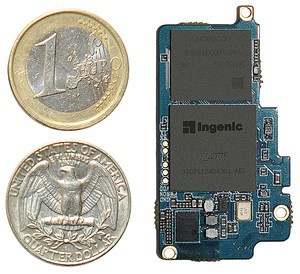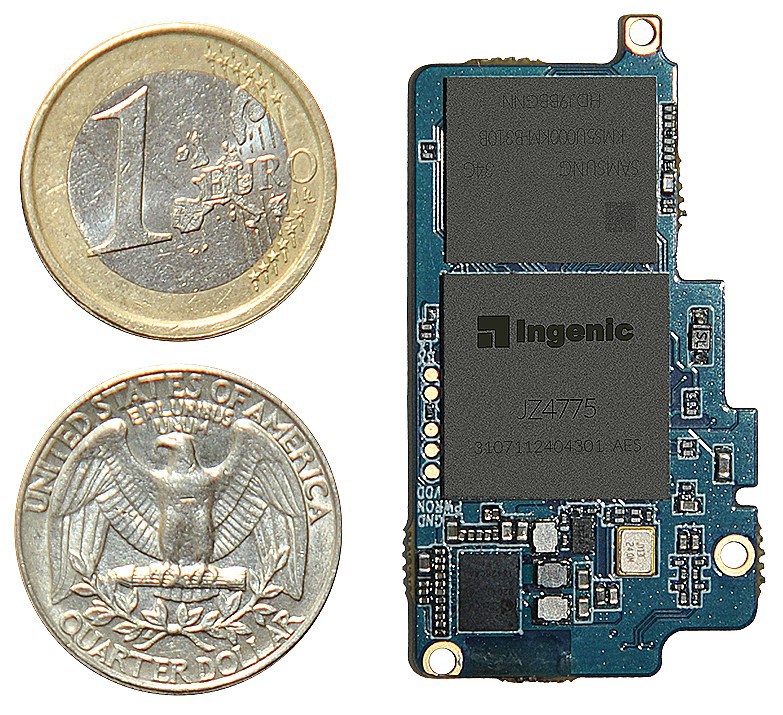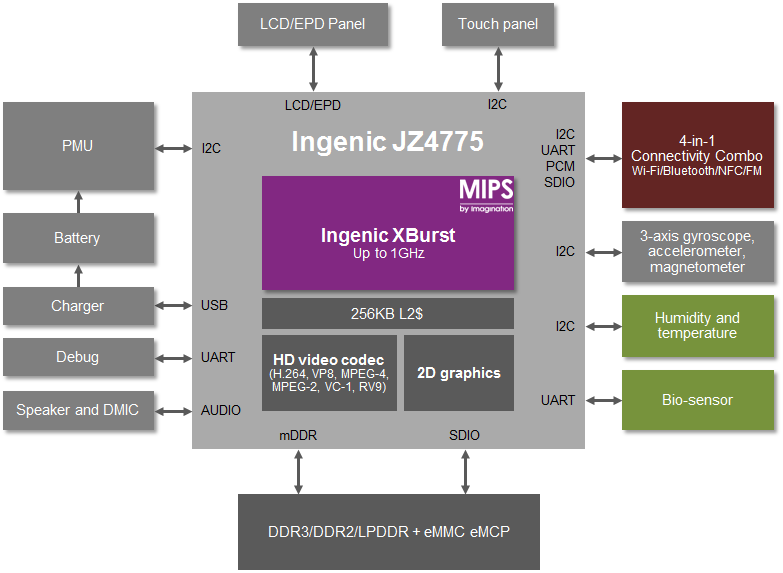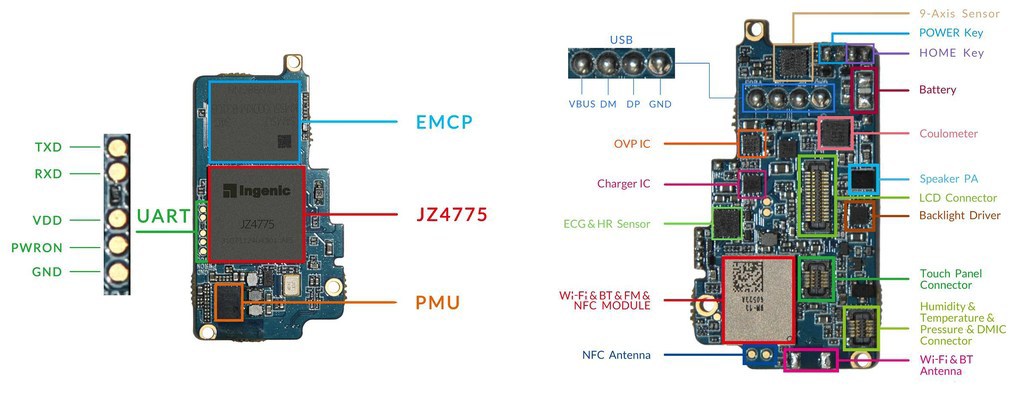Newton's MIPS module - Intel's Edison competitor for use in wearable computers

Ingenic introduced tiny, MIPS-based, Newton COM for wearable computers and IoT devices running on Android or Linux under the Xburst SoC, and with built-in WiFi and other sensors.
The Newton computer platform was reported by both Chinese semiconductor company Ingenic Semiconductor and Imagination Technologies, which licenses MIPS intellectual property for Ingenic. The Imagination message only related to wearable computers, and Ingenic only mentioned them as the first in a series of Internet of Things (IoT) applications.
In addition, Newton can be used in healthcare, household appliances, security, biometrics, industrial control and consumer electronics. Imagination is also looking to use Newton as a platform for Google’s new Android Wear, although Ingenic hasn’t mentioned it.
')
Photo Ingenic Newton closeup:

A competitor to Newton COM could be the Edison module, which Intel announced in January. Like Edison, Newton, whose size is 39x22 mm, supports Linux, as well as Android - unlike Edision. It is about the size of an SD card. On March 28, Intel talked about its plans in more detail, stating that before the release of the Quark-based product, she would introduce the Edison version on the dual-core Intel Atom SoC, with the result that the model would be slightly larger than the SD card.
Newton has implemented the Ingenic 32-bit MIPS-based XBurst “On-Chip” system, which is used in more than 40 million devices, including tablets, e-book readers, multimedia players and wearable computers. In Newton used a relatively new JZ4775 XBurst SoC. This is a stripped-down version of the 1-GHz JZ4770, which can be found in products like the Linux-based GWC Zero gaming console. It is even more similar to the JZ4774 used in Geak Watch on Android.
Block diagram of Ingenic JZ4774:

In JZ4775, instead of the Vivante GC860 GPU, which is used in the JZ4770, a much simpler 2D GPU is used, the video accelerator of which only supports 720p resolution, not 1080p. The camera resolution is half the size of the JZ4770, - 2048x2048 pixels. On the other hand, the JZ4775 has improved memory support, including DDR3 RAM at speeds up to 800 Mbps, Toggle NAND and NAND, as well as 64-bit ECC memory.
The JZ4775 is also more energy efficient than the JZ4770. According to the company, Newton COM consumes from 80 to 260 mW during operation, and in standby mode - less than 4 mW. According to Imagination, created on the basis of Newton "smart watch" can work more than 30 hours on a single charge.
Front and rear view of Newton COM (clickable):

Newton comes with 3 GB DDR1 RAM and 32GB eMMC flash memory. The module is equipped with a LCD interface with touch input support and backlight, as well as an E Ink EPD controller for monochrome electrophoretic displays. There is a WiFi and Bluetooth 4.0 connection, as well as NFC and FM radio through a common 4-in-1 module.
For use in wearable devices, a 3-plane gyroscope, an accelerometer and a magnetometer, temperature, humidity and pressure sensors are integrated into the module. Health and fitness assessment applications can use the built-in ECG biosensor. I / O interfaces are designed for USB 2.0, I2C, UART, GPIO and “motor control”, although the latter may be related to UART or GPIO interfaces.
Newton can be powered by USB or battery and is equipped with a power management microcontroller (PMU). Imagination emphasized that PMU is not integrated into the processor itself, which is in line with the Ingenic modular approach. "Users can remove unwanted components from the module to reduce the cost of BOM," noted in Imagination.
Supported operating systems –Linux 3.0.8, Android 4.4 (KitKat) and several RTOSe (open source real-time operating systems). Ingenic also provides specialized software sets for developing interfaces that are controlled by voice or gestures.
Specifications for Newton include:
- Processor - Ingenic JZ4775 (1x XBurst core up to 1 GHz); cache 256 KB L2
- Memory - 3GB LPDDR1; 32GB eMCP eMMC Flash
- Display - support for LCD or EPD (electronic paper) displays with sensor and backlight
- Audio - DMIC; speakers
Wireless options:
- 802.11 a / b / g / n (2.4GHz and 5 GHz)
- Bluetooth 4.0 + EDR and BLE
- FM
- NFC
Sensors:
- 3-plane gyroscope
- 3-plane accelerometer
- 3-plane magnetometer
- ECG sensor
- Pressure sensor
- Humidity sensor
- Temperature sensor
Other I / Os:
- USB 2.0
- I2C
- UART
- GPIO
- "Motor support"
Other features are the Power and Home buttons.
Power supply - USB or battery, with PMU and charger
Electricity consumption:
- <4 mW in standby
- <80 mW minimum load
- <100 mW in MP3 playback mode
- <260 mW maximum load
Dimensions - 38x22x3 mm
The operating system is Linux 3.0.8, Android 4.4 (KitKat), several RTOSe.
Platform for Android Wear?
Google did not mention Ingenic separately in its recent post on the Android Wear platform for Android-based wearables, but Imagination Technologies is on the list, as are semiconductor manufacturers Broadcom, Intel, Qualcomm, Mediatek and Samsung. Imagination emphasizes that it is the only IP supplier on the list, and not the SoC manufacturer.
“This means that MIPS, PowerVR and Ensigma licensees will be the first to get access to the latest resources from Google and the chance to better optimize their platforms for the next generation of wearable devices,” said Alexandru Voica from Imagination on his blog. “In the coming months, we will focus on several full-featured, high-performance platforms that use Imagination's hardware IP to create innovative solutions for a new wave of mobile devices.”
All this creates the impression that Newton is a platform ready for Android Wear, although it was never exactly asserted, and Ingenic does not mention this. In late January, Wojk of Imagination published a blog post that Ingenic XBurst is being used in a number of “smart watches”, including those using Android — Geak Watch, YiFang Digital NextOne and Tomoon T-Fire.
Imagination acquired MIPS just over a year ago for $ 100 million, and since then its shares have fallen in price by half, according to a recent Forbes report. But wearable computers can become a “lifesaver” for MIPS and Imagination. MIPS is also counting on its Warrior processor platform for Android, including the MIPS Series5 Warrior-P “on-chip” system, equipped with six 32-bit MIPS P5600 cores, which are twice as productive as previously used.
MIPS was also the first non-ARM architecture ported to Android, but its use with partners such as tablet maker Velocity Micro did not lead to much success. MIPS even announced the creation of Android-based MIPS phones, but so far nothing is known about them.
Further information
Ingenic did not say what the price of Newton will be and when it will be available. Additional information can be found on the Ingenic Newton product page and in the Imagination Technologies Newton ad.
A source:
Intel's Edips in wearables MIPS-based Newton module
Ingenic Newton - Smart Connected Devices Platform
Newton Hardware Manual
From the wiki about Ingenic Semiconductor
Source: https://habr.com/ru/post/219355/
All Articles